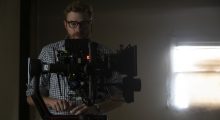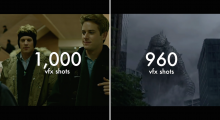David Fincher
-
“If a Director Feels the Need to Move the Camera Simply to ‘Make It Interesting,’ It’s Likely an Indicator the Scene Itself Isn’t That Interesting”: DP Erik Messerschmidt on Mindhunter, Season Two

When David Fincher transitioned from music videos to feature films in the 1990s, the descriptors “glossy,” “slick” and “stylized” were frequently affixed to his work. Those adjectives were often aimed as pejoratives, categorizing Fincher as a technical virtuoso who created shiny but hollow thrillers. Watching the second season of Netflix’s Mindhunter—executive produced and partially directed by Fincher—the evolution of the filmmaker’s aesthetic is striking. As FBI profilers Bill Tench (Holt McCallany) and Holden Ford (Jonathan Groff) interview America’s most notorious serial killers, the camera rarely moves. Instead, it unobtrusively observes. What hasn’t changed over the years is Fincher’s unwavering exactitude, […]
by Matt Mulcahey on Sep 17, 2019 -
Back to One, Episode 68: Damon Herriman

It’s rare for one actor to be cast as the same real-life character in two different productions almost simultaneously. When that real life character is Charles Manson, that makes some news. Australian actor Damon Herriman has taken on this challenging role in both Quentin Tarantino’s Once Upon A Time… In Hollywood and the second season of David Fincher’s Netflix series Mindhunter. Herriman is perhaps best know for playing Dewey Crowe in the series Justified and currently plays Paul Allen Brown in Perpetual Grace LTD. We talk about the character of Manson, how good writing makes for good acting, and why […]
by Peter Rinaldi on Jul 30, 2019 -
Watch: Zodiac‘s Commitment to Historical Accuracy

David Fincher is notoriously detail-oriented, but this video from the Film Radar account argues that Zodiac goes above and beyond in this respect. To make the point, this video examines two of the murders recreated in the film, juxtaposing the filmed version with testimony of survivors, emergency line recordings and other archival/interview materials. Warning: contains both spoilers and stabbings.’
by Filmmaker Staff on Apr 10, 2018 -
In the Light of History: Rachel Morrison on Shooting Mudbound

With Rachel Morrison the first woman cinematographer nominated for a Best Cinematography Academy Award, we’re running today online from our current print issue David Leitner’s interview with her about shooting her nominated film, Dee Rees’s Mudbound. When Dee Rees’s Mudbound premiered at the 2017 Sundance Film Festival, the director was returning to the fest six years after her feature debut, Pariah, launched there. The same year also marked DP Rachel Morrison’s first feature to be included in the festival, Zal Batmanglij’s Sound of My Voice, and she returned the following year with Ryan Coogler’s Fruitvale Station; Mudbound is her eighth […]
by David Leitner on Jan 23, 2018 -
DP Erik Messerschmidt on Shooting Netflix’s Mindhunter with a Custom Red Xenomorph

When mere mortals gear up for a job, they are restricted to selecting cameras currently in existence. Not David Fincher. Fincher has long hated all the gak required to make a digital cinema camera functional: a wireless transmitter to get signal to video village, the add-ons to provide wireless iris and focus control, the assistant camera’s onboard monitor hanging off the side — all the things that turn a small, lightweight camera body into a labyrinth of cables and breakout boxes. Red Digital Cinema responded by making Fincher his own set of custom Weapon Red Dragons for use on the […]
by Matt Mulcahey on Oct 26, 2017 -
Watch: How David Fincher Hijacks Your Eyes

Why is David Fincher’s work so hypnotic? This video essay from The Nerdwriter argues that he matches camera movement exactly to the speed of the characters, placing you more in sync with them both physically and emotionally.
by Filmmaker Staff on Oct 24, 2017 -
NYFF 2017: Mindhunter (Episodes 1-2), Good Streamable Chronological Narrative Content

The first two episodes of Netflix’s Mindhunter, directed by David Fincher, are slightly stylistically diluted but still distinctively his. Fincher also directed the last two episodes of the ten-episode first season, which has already been renewed for a second prior to dropping this Friday — whether I make it to his bookending episodes I have no idea, but fans should at least take a look at this starting point. “Peak TV,” or at least the limited-run series, has increasingly accommodated one director who wants to do it all: this year has seen airings of Paolo Sorrentino’s The Young Pope, Jean-Marc Vallée’s Big Little […]
by Vadim Rizov on Oct 12, 2017 -
Watch: “David Fincher — Invisible Details”

David Fincher is famously a technical wizard, but most of his special effects use is designed not to be perceived. Kristian Williams dives into some of his most inconspicuous applications of VFX.
by Filmmaker Staff on Jun 6, 2017 -
Watch: “David Fincher: From a Distance”

In his latest video, Jacob T. Swinney inspects David Fincher’s approach to the long shot. Clips from Fight Club, Zodiac and The Girl with the Dragon Tattoo, among others, serve as examples of the filmmaker’s use of distance. Supplementally, you can also watch Swinney’s previous video, David Fincher’s Extreme Close-Ups.
by Marc Nemcik on Jun 14, 2016 -
Watch: David Fincher on Actors and His Movies

The emphasis in this edited series of highlights from David Fincher’s recent BFI talk is, refreshingly, more on the actors than on his much-dissected, formidable technical acumen. One key takeaway from this brisk trot through his career is Fincher’s take on his infamous penchant for endless takes. “My philosophy is, you spend $250,000 on a set,” he explains. “Put it on a soundstage, it costs you $5,000 a day. You’re gonna put $8,000 of lights and you’re gonna bring a $150,000 crew in. You’re gonna bring actors in from all over the world, you’re gonna put them up in hotels, […]
by Vadim Rizov on Jan 8, 2015
